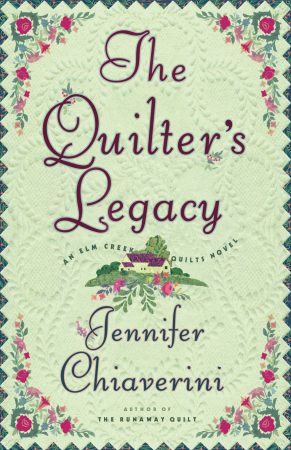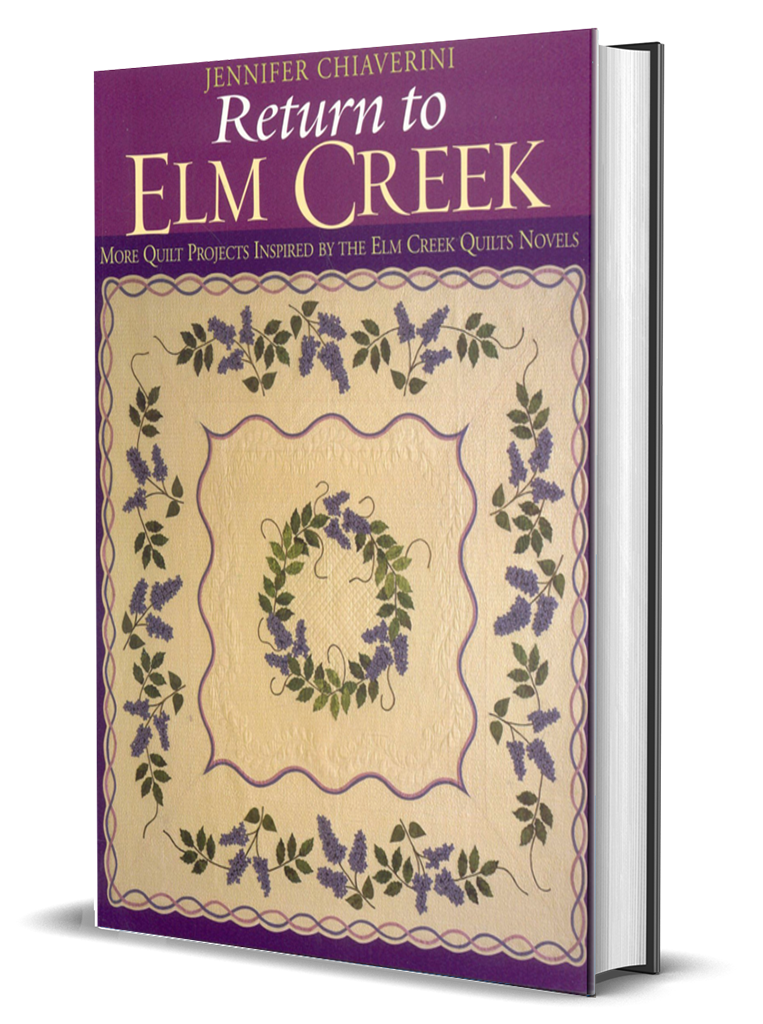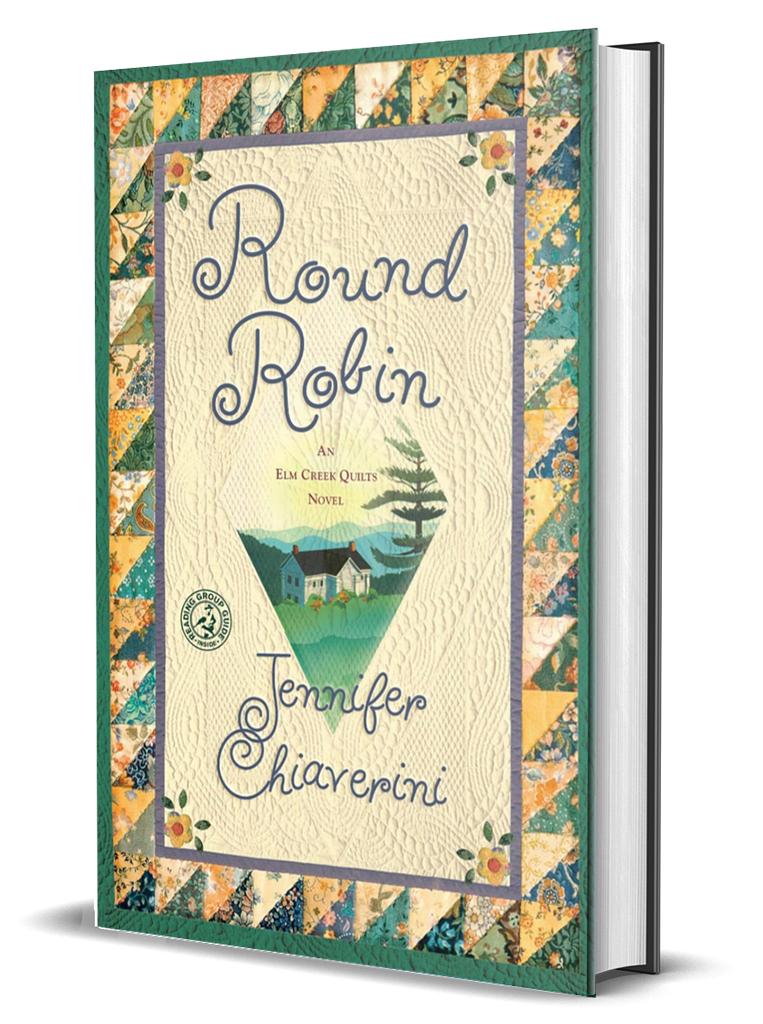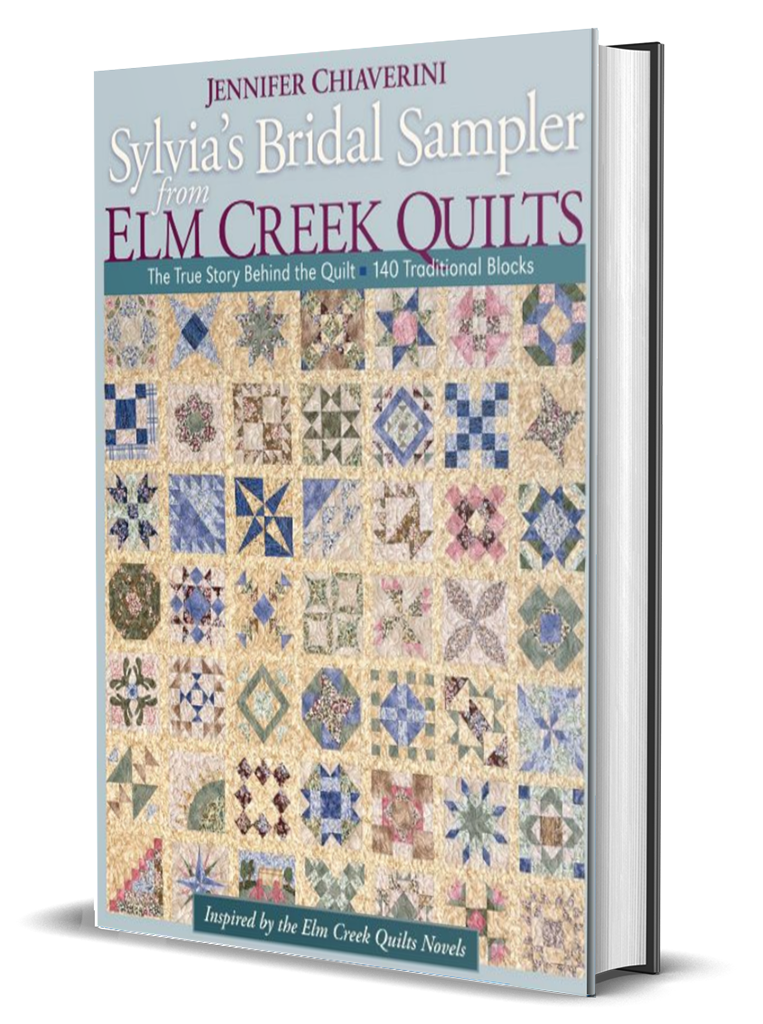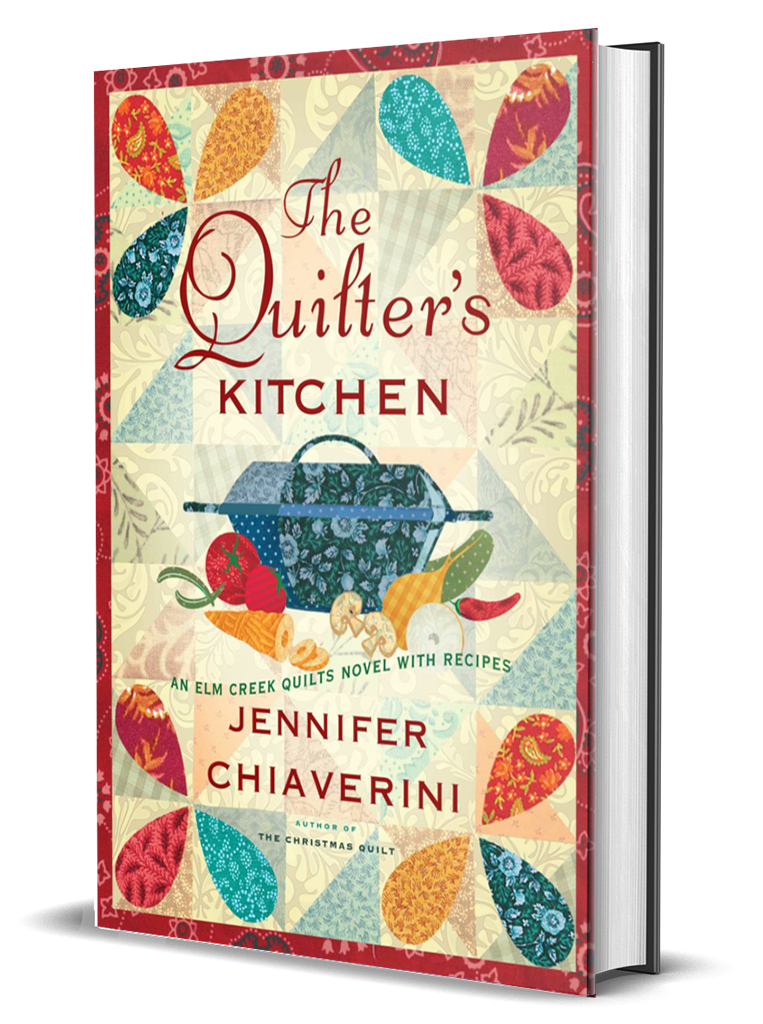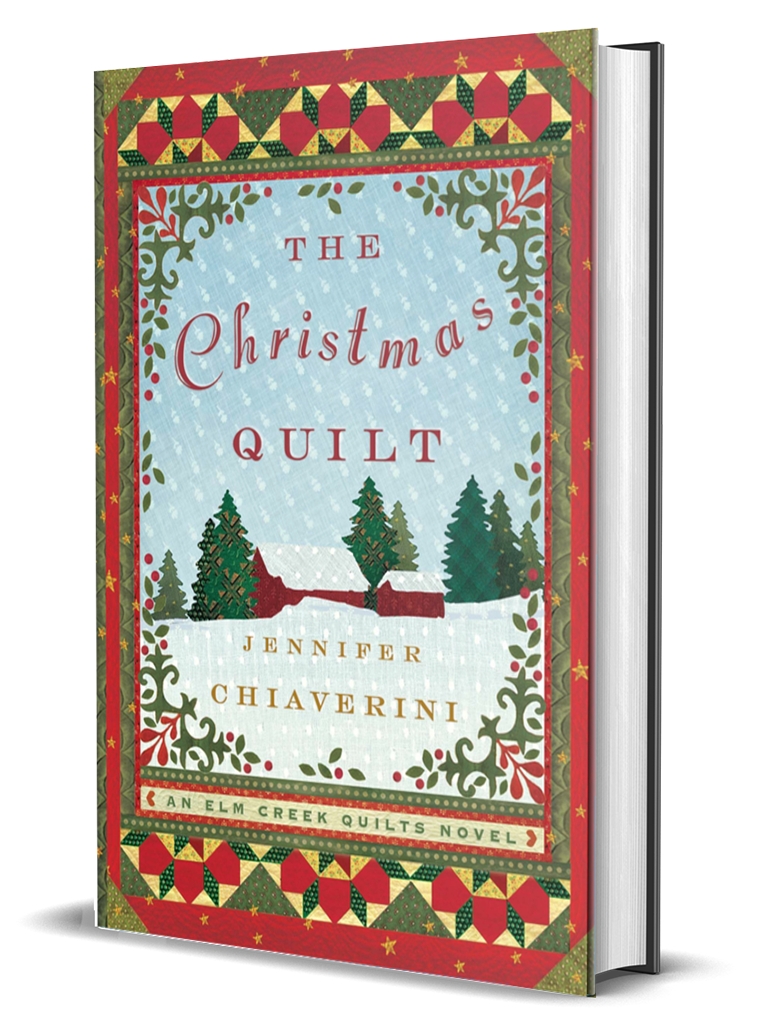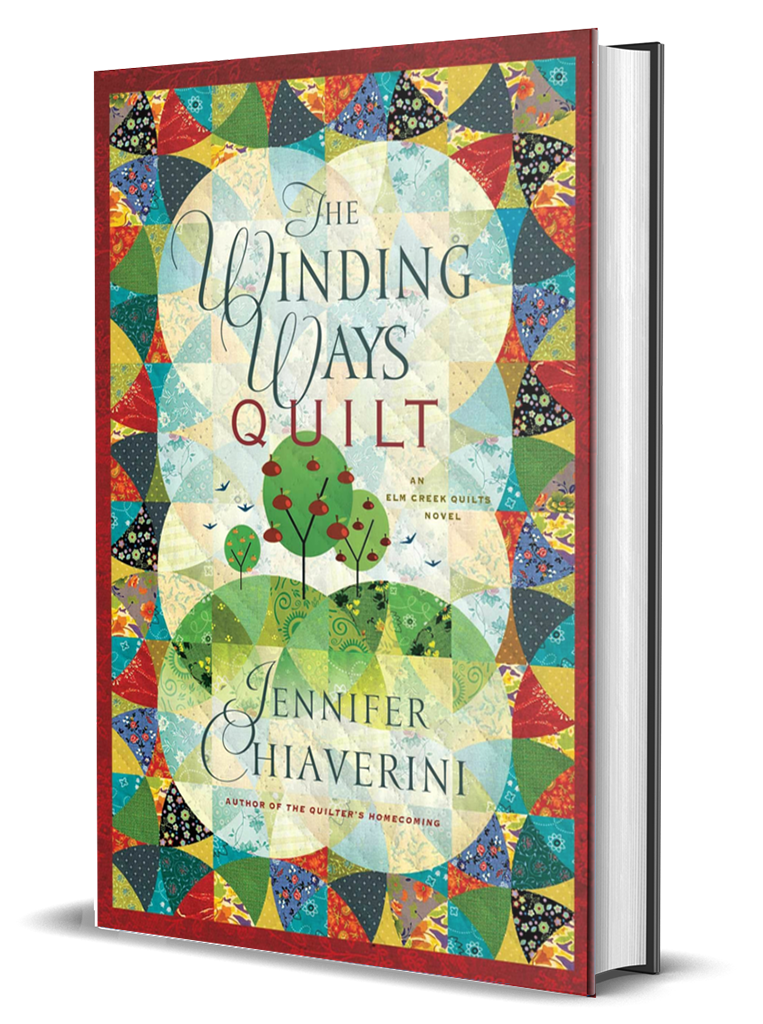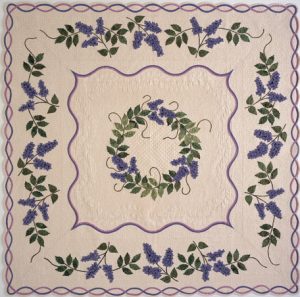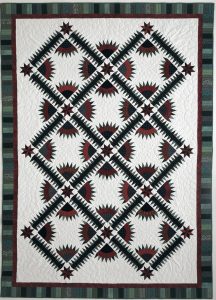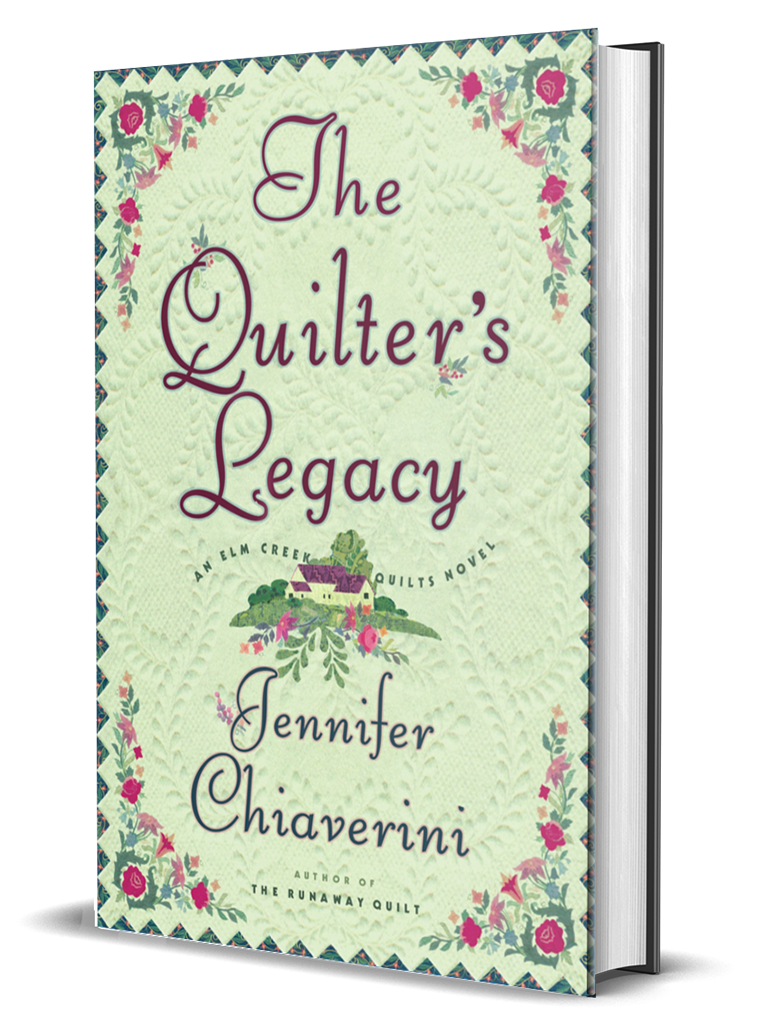
The Quilter’s Legacy
When precious heirloom quilts hand-stitched by her mother turn up missing from the attic of Elm Creek Manor, Sylvia Bergstrom Compson resolves to find them. Her quest leads her to unexpected places, where offers of assistance are not always what they seem.
Readers of Jennifer Chiaverini’s popular and engaging Elm Creek Quilts series are treated in each successive volume to storytelling that expertly weaves the joys and intricacies of history, quilting, and family ties. In THE QUILTER’S LEGACY, a daughter’s search for her mother’s treasured heirlooms illuminates life in Manhattan and rural Pennsylvania at the turn of the last century.
When precious heirloom quilts hand-stitched by her mother turn up missing from the attic of Elm Creek Manor, Sylvia Bergstrom Compson resolves to find them. From scant resources — journal entries, receipts, and her own fading memories — she pieces together clues, then queries quilting friends from around the world. When dozens of leads arrive via the Internet, Sylvia and her fiancŽ, Andrew, embark on a nationwide investigation of antiques shops and quilt museums.
Sylvia’s quest leads her to unexpected places, where offers of assistance are not always what they seem. As the search continues, revelations surface about her mother, Eleanor Lockwood, who died in 1930, when Sylvia was only a child. Burdened with poor health and distant parents, Eleanor Lockwood defied her family by marrying for love. Far from her Manhattan home, she embraced her new life among the Bergstroms — but although warmth and affection surrounded Eleanor at last, the Bergstroms could not escape the tragedies of their times.
As Sylvia recovers some of the missing quilts and accepts others as lost forever, she reflects on the woman her mother was and mourns the woman she never knew. For every daughter who has yearned to know the untold story of her mother’s life, and for every mother who has longed to be heard, THE QUILTER’S LEGACY will resonate with heartfelt honesty as it reveals what tenuous connections bind the generations and celebrates the love that sustains them.
Praise for The Quilter’s Legacy
Read an Excerpt from The Quilter’s Legacy
Sylvia supposed all brides-to-be considered eloping at some point during the engagement, but she had never expected to feel that way herself, and certainly not a mere few weeks after agreeing to become Andrew’s wife. She shook her head as she flipped through the magazines someone had left on the desk–Brides, American Bride, Country Bride–and dumped the whole stack into the trash can. Unless they came out with an edition of Octogenarian Bride, she would leave the pleading overtures of the bridal industry to the younger girls. Surely she could fend for herself when all she and Andrew wanted was a small, private ceremony in the garden.
The door to the library swung open, and in walked her young friend and business partner, Sarah McClure, neatly dressed in jeans and a button down shirt, the glasses she wore only reluctantly tucked into the breast pocket. She carried a small white box in one hand. “Do you have a moment?”
“Yes. I was just doing some light housekeeping.” Sylvia gestured to the trash can. “Are you responsible for this?”
“Are you kidding? After you scolded me for offering to take you shopping for your wedding gown?”
“I’m glad you learned your lesson.” Sylvia frowned. Who could it have been, then? All of the Elm Creek Quilters had free run of the office. Summer spent more time there than anyone but Sarah, but she was not the bridal magazine type. “Diane,” she declared. “Just yesterday I overheard her say that this will be her only chance to plan a wedding because both of her children are boys. Do you suppose she forgot the magazines or left them deliberately, hoping I would be caught up in the wedding planning frenzy that seems to have captivated everyone else around here?”
“Ask her yourself,” said Sarah, smiling. “She and Agnes are coming over to discuss new courses for next season.”
“Already? Elm Creek Quilt Camp won’t open until spring.”
“They don’t have a lot to do now that the quilters’ retreat is closed for the season. Would you rather have them work ahead on next year’s classes or plan your wedding?”
“I suppose you’re right.”
“You can’t blame us for being excited. After you turned down Andrew the third time, most of us gave up hope that you two would ever get married.”
“If you were disappointed, it was your own fault for treating our relationship like a spectator sport.”
Sarah laughed. “I wasn’t disappointed. I always knew it would happen eventually. In fact, I’ve been saving this for months with this occasion in mind.”
She set the box on the table.
“What’s this?” asked Sylvia, wary. “I distinctly said we did not want any engagement gifts.”
“This doesn’t really count.”
“How could it not count? It’s in a wrapped box; it’s quite obviously a gift.” But Sylvia smiled and unwrapped it. Inside was nestled a pair of silverplated scissors fashioned in the shape of a heron. “My goodness.” She slipped on her glasses and studied the scissors, astonished. “My mother had a pair exactly like these. Where on earth did you find this?”
“In your attic, earlier this summer when we were looking for your great-grandmother’s quilts,” said Sarah. “You ordered me back to work every time I got sidetracked, so when I found them, I set them aside to show you later. When you found the quilts, I forgot about the scissors in all the excitement.”
“In the attic. Then–” The weight and shape of the scissors felt so familiar in her hands that she could have described the pattern of nicks on the blades with her eyes closed. “Then these must be my mother’s. I should have known them immediately. Did you know these were given to her by the woman who taught her to quilt? An aunt, or someone. My mother was just a girl when she used these scissors in making her first quilt.”
“I thought you might like to use them when you make your bridal quilt.”
Sylvia nodded, scarcely hearing as she turned over the scissors in her hands. When she closed her eyes, she could picture her mother slicing through fabric with a sure and steady hand, cutting pieces for a dress or a quilt. She remembered sitting beneath the quilt frame as her mother and aunts quilted a pieced top, eavesdropping on their conversation, watching as they worked their needles through the layers of fabric and batting. The weight of her mother’s scissors as they rested on the quilt top made the layers bow at her mother’s right hand, the depression vanishing and reappearing, accompanied by a brisk snip as her mother trimmed a thread. Those were the same scissors Sylvia and her elder sister, Claudia, had fought over as they raced through their first quilt project, each determined to complete the most Nine-Patch blocks and thereby earn the right to sleep beneath the quilt first. It was a wonder the scissors had not been damaged beyond repair that wintry afternoon, the way Claudia had flung them across the room in frustration when she tried to pick out a poorly-sewn seam and jabbed a hole through her patches instead.
“What pattern are you going to use?”
Sylvia looked up. “Hmm?”
“What pattern are you going to use for your wedding quilt?” Sarah regarded her, curious. “You are planning to make one, aren’t you?”
“I honestly hadn’t thought about it,” said Sylvia. “Do you think Andrew expects a wedding quilt?”
“‘Expects’? No, I don’t think he expects one, but don’t you want one? You’ll need something for your new bed anyway, unless you’re planning to squeeze both of you into yours or Andrew’s.”
“Oh, of course,” Sylvia said. “You’re right. We’ll need something.”
Sarah’s eyebrows rose. “Did you forget about that part? Most married people, you know, cohabit. Unless you were planning on twin beds a discreet distance apart?”
“Our sleeping arrangements are none of your business.” Then Sylvia paused. “Actually, I suppose this sounds foolish, but I forgot we would be sharing a room.”
Sarah put an arm around her. “I know it’s probably been a while, but there’s nothing to be nervous about. Especially with Andrew. I’m sure he’ll be–”
“No, you don’t understand,” said Sylvia. “I’m not talking about what you think I’m– You’re going to force me to say it, aren’t you? Very well, then. Sex. I’m not talking about sex. I said share a room, not share a bed.”
“I think you should be prepared to do both,” said Sarah carefully. “Andrew might be disappointed if you don’t want–”
“I said I’m not talking about sex,” exclaimed Sylvia so forcefully Sarah jumped back in surprise. “Andrew and I will be fine in that department, and that’s the last I’ll say on the subject. My concern is with my room. I haven’t shared a bedroom since–well, since James passed. Before then, even. Since he went overseas.”
“I see. You’re used to having a room of your own. Your own space.”
“Precisely.” If her bedroom didn’t reflect Andrew’s tastes and interests as well her own, he would feel more like a visitor than an occupant. Hardly anyone but herself ever entered the adjoining sitting room, one of her favorite places to read or sew when she wanted solitude. Would she have to shove her fabric stash aside to make room for Andrew’s fishing gear? “I don’t think there’s enough space in my suite for two people.”
“Didn’t you manage to make room for James when you married him?”
“That was different. I was younger. I didn’t have so many things, and neither did James.” When Sarah looked skeptical, Sylvia added, “Besides, when James came to live at Elm Creek Manor, I left my old bedroom and we moved into the suite together. That made it our room, not merely mine.”
“Why don’t you and Andrew do the same? You could move into the master suite on the third floor.”
“I couldn’t. That was my parents’ room.”
“But it’s just sitting there empty and it’s the largest suite in the manor.”
“I suppose,” said Sylvia, reluctant. But that would not solve the problem. She was content with her room as it was. It was private and it was hers. She did not want to change it or move somewhere else, but what was the point of getting married if they meant to leave things exactly as they were?
Sylvia stroked the heron scissors with a fingertip and carefully returned them to the box. She would just have to get used to the idea. If she let Andrew know how she felt, he might think she was having second thoughts about marrying him.
Whatever they decided about the room, they were still going to need a quilt. Sylvia could no longer sew as swiftly as she had before her stroke, and she did not want a half-finished quilt covering their bed on their first night as husband and wife. She could ask the Elm Creek Quilters for help, or–
“I know just the thing.” Sylvia rose from her chair, tucking her mother’s scissors into her pocket. “Thank you, Sarah. Your gift has inspired me.”
“Where are you going?”
“Up to the attic, to look for my mother’s bridal quilt.”
Sylvia stifled a laugh, amused by Sarah’s baffled expression. It was nice to know that in spite of their closeness , Sylvia could still surprise her young friend.
Sylvia went upstairs to the third floor, then climbed up the narrow, creaking stairs to the attic. Rain drummed on the roof as she fumbled for the light switch Matt had only recently installed. The overhead light illuminated the attic much better than the single, bare bulb it had replaced, but even now the sloped ceiling and the stacks of trunks, cartons, and the accumulated possessions of four generations cast deep shadows in the corners of the room.
Directly in front of her stretched the south wing of the manor, added when her father was a boy; to her right lay the older west wing, the original home of the Bergstrom family, built in the middle of the nineteenth century by her great-grandparents and her great-grandfather’s sister. Only a few months before, Sylvia had searched the attic for the hope chest her great-aunt Lucinda had described, the one containing her great-grandmother’s quilts. One of those quilts, the family stories told, had acted as a signal to runaway slaves in the years leading up to the Civil War, beckoning fugitives to the sanctuary of a station on the Underground Railroad. Sylvia had found the hope chest and much more, for it had contained three quilts made by her ancestors and a journal, a memoir written by Gerda Bergstrom, her great-grandfather’s sister. Within its pages Gerda confirmed that Elm Creek Manor had indeed been a station on the Underground Railroad, but the particular circumstances differed greatly from the idealized tales handed down through the generations.
Despite the new uncertainties about her heritage, Sylvia still knew much more about her father’s side of the family than her mother’s. Until that summer she had excused her ignorance as a consequence of growing up on the Bergstrom family estate; naturally her father’s family tended to talk about their own. Her mother died when Sylvia was only ten years old, and the few stories her mother had shared about her youth were almost certainly edited for a young girl’s ears. Her mother spoke of strict, wealthy parents who raised her to be a proper young lady, and since this was the very sort of well-behaved child Sylvia invariably failed to emulate, her mother’s stories seemed like dull morality tales. Sylvia eventually decided that the Bergstrom family was far more interesting than the Lockwoods, and paid little attention when that distant look came into her mother’s eyes as she remembered events long ago and far away.
The events of the past summer had pricked Sylvia’s conscience, and for the first time in her life, she regretted neglecting an entire half of her heritage. Sarah’s gift–the silverplated scissors Sylvia had so often seen in her mother’s hand–had flooded her mind with images and conversations long forgotten, and a warmth of remembered love. Mother had tried to pass on more than quilting skills as she taught Sylvia how to work a needle. If only she had paid more attention to her mother’s reminiscences, she might feel as if she had truly known her, and known her family. Now all Sylvia had were her memories and the incomplete list of names, birthdates, baptisms, marriages, and deaths recorded in the Lockwood family Bible.
She surveyed the attic. Somewhere in one of those trunks or cartons were her mother’s quilts. Claudia must have stored them up here, for upon Sylvia’s return to the manor after Claudia’s death, only a few of Mother’s most worn utility quilts had been spread on beds in the rooms below, awaiting guests who never came. Her mother’s bridal quilt was sure to be among those that had been put away for safekeeping.
“Now, where to begin?” mused Sylvia. The search earlier that summer had focused on a specific hope chest, so she had often ignored those that did not fit the description. Still, she had opened enough, just in case, to detect a pattern within the clutter. The newest items were closest to the stairs, as if Claudia or her husband had merely stood on the top step and shoved the boxes inside. Moving deeper into the attic was like stepping back in time, with an occasional object from another era juxtaposing the past and present: an electric lamp missing its shade rested on top of a treadle sewing machine; a pile of Sylvia’s schoolbooks sat on the floor beside a carton of clothing from the seventies. For the most part, however, the pattern held true, and since Sylvia had found Gerda Bergstrom’s journal in the deepest part of the west wing, possessions from her mother’s era ought to be somewhere in the middle of the south wing.
She chose a trunk at random and tugged it into the open, and had just lifted the lid when she heard the stairs creaking. She turned to find Agnes emerging from the opening in the floor. “Oh, hello, dear,” Sylvia greeted her. “Did you finish your business with Sarah and Diane?”
“We didn’t even get started,” said Agnes, touching her curly white hair distractedly. “Once Sarah told me what you were up to, I came right upstairs.”
“If you came to help, you’re a brave soul. It took me weeks to find Gerda’s hope chest.”
“Sylvia.” Agnes hesitated, removed her pink-tinted glasses, and replaced them. “About your mother’s quilt–”
“Oh, yes, of course,” exclaimed Sylvia, suddenly remembering. “You’ve seen it. The burgundy, green, and black New York Beauty quilt, remember? It was on the bed of your guest room when you visited us that first time.” She chuckled and lifted the lid of the cedar chest. “We used it for only our most important visitors, but you apparently had no idea how we had honored you. The next morning, when you complained about how cold you had been all night, I wanted to snatch it off your bed and give you a few scratchy wool blankets instead. I would have, except my brother would have been furious.”
“I don’t remember complaining…” Agnes shook her head and began again. “Sylvia, dear, I hope you don’t have your heart set on using your mother’s bridal quilt.”
“I don’t plan to, not every day. Just on our wedding night.” She sensed Agnes’s dismay and amended her words. “I wouldn’t damage an antique quilt just to indulge a whim. If it seems too fragile, I’ll just display it at the reception instead.”
“I’m afraid that won’t be possible, Sylvia.” Agnes took a deep breath. “The quilts aren’t here.”
“Of course they are. They must be. I’ve been everywhere else in the manor.”
“I don’t mean they aren’t in the attic. They aren’t in the manor. Claudia sold them.”
“What?”
“She sold them. All of them, except for the utility quilts.”
“I don’t believe it.” Sylvia steadied herself with one hand on the trunk, then slowly closed the lid and sank to a seat upon it. “Not even Claudia could have done such a thing. Not even Claudia.”
“I’m so sorry.” Agnes worked her way through the clutter and sat down beside her. “After the family business failed, the money ran out. Claudia and Harold sold off the horses, acres of land, furniture, anything to raise cash. I–I did, too, of course, but mostly to keep them from selling off the rest of the land and the manor with it.”
“She sold Mother’s bridal quilt?” Sylvia’s voice sounded dull and thick in her ears.
“And the others, her other fine quilts.” Agnes took Sylvia’s hands. “I would have prevented it if I could have. I wish you knew how hard I tried.”
“I’m sure you did.” Sylvia gave Agnes’s hand a clumsy pat and pulled away. She rarely allowed herself to imagine what life in Elm Creek Manor had been like after her angry and abrupt departure, but for Agnes, it must have been a nightmare. Sylvia suspected she owed the survival of what remained of the estate to her sister-in-law. Agnes never spoke of those days, which Sylvia considered a kindness. What she imagined pained her enough.
She never should have run away.
“When Claudia made her up her mind, there was no reasoning with her,” said Sylvia. “The quilts were hers to do with as she wished, since I abandoned them. It’s not your fault she sold them.”
“But –”
“It’s not your fault.” Suddenly the attic seemed dark and confining. “It’s mine.”
Sylvia left the attic without another word, without looking back. She retreated for the sanctuary of her sewing room adjoining her bedroom. Ordinarily she preferred to quilt in the bright cheerfulness of the west sitting room on the first floor where friends came and went as they pleased, but she was too distressed now to welcome company. She brooded as she worked on her Tumbling Blocks quilt, piecing the diamond shaped scraps together and thinking about her sister.
The fading light reminded her she had spent too much time alone with her thoughts. Tonight was supposed to have been her turn to prepare supper for herself, Andrew, Sarah, and Sarah’s husband, Matt, but Agnes’s revelation had driven all thoughts of eating from her mind. She set her quilting aside and hurried down the grand oak staircase, across the marble floor of the foyer, and down the west wing toward the kitchen. When camp was in session, they served breakfast in the banquet hall off the foyer, but in the off-season, they preferred the intimacy of the kitchen.
Andrew and Matt were setting the long wooden table for four when she entered. “Glad you could join us,” said Sarah as she took a steaming casserole dish from the oven.
Andrew took her hand and kissed her on the cheek. “Are you feeling any better?” he asked in an undertone.
“Who said I was feeling poorly?”
“You shut yourself in your room all day,” said Andrew. “That’s usually a pretty good sign.”
“It’s nothing,” she said, giving his hand a pat and forcing a smile. “I’ll explain later.”
But Sarah’s curiosity would not wait. They were barely seated when she gave Sylvia a searching look and said, “Did you and Agnes have an argument? She came down from the attic upset about something, but when I asked what was wrong, she just shook her head and asked Diane to drive her home.”
“We didn’t argue,” said Sylvia, and told them what she had learned about the fate of her mother’s quilts.
“Oh, Sylvia,” said Andrew, his brow furrowed in concern. “That’s a real shame.”
“It can’t be helped,” she said briskly when Sarah and Matt nodded in sympathy. “What’s done is done, and I have only myself to blame. If I hadn’t run away– ”
“Don’t blame yourself,” said Sarah.
“Oh, don’t worry, dear. I’ve set aside plenty of blame for my sister, too. I don’t understand how she could have parted with our mother’s quilts.” She waved her hand, impatient. “I’ve sulked about this enough for one day. May we please change the subject? I’d rather talk about anything else, even the wedding.”
“That’s good,” said Sarah, “because Diane wants Andrew to find out how many of his grandchildren are coming in case we need to set up a special playroom for them during the reception.”
“She’s moving right along, isn’t she?” said Sylvia. “I suspect she’ll have my dress picked out soon.”
Andrew looked dubious. “I think my grandkids are too old to be interested in a playroom unless it has video games, but I’ll ask.”
“I suppose we ought to set a date before Diane does,” said Sylvia. “Did you find out when the grandkids will be out of school for the summer?”
Andrew shrugged. “I forgot to ask.”
Sylvia gave Sarah and Matt a knowing look. “What he means is that he still hasn’t summoned up the courage to tell his children we’re engaged.”
“That’s not the kind of news you spring on someone over the phone,” protested Andrew.
Sarah’s eyebrows rose. “You say that as if you don’t expect them to be happy for you.”
“They will be,” said Andrew, “once they get used to the idea.”
Sylvia patted his arm. “I love you, dear, and I promise I’ll marry you with or without your children’s blessing, but I think we should tell them soon, before they hear about it from someone else.”
“I want to tell them in person.”
“Do you really think that’s necessary?”
Andrew nodded.
“Very well. Shall we break the news together?”
“I’d like you to travel with me, but I’ll tell them myself, alone. Bob first, and then Amy. Bob knows how to keep a secret, especially if I tell him it’s important, but Amy would be on the phone to her brother within five minutes.”
Clearly he had given the matter a great deal of thought. “I’m sure we’ll have a lovely visit and they’ll be delighted for us,” said Sylvia. She smiled encouragingly and squeezed his hand, wishing she felt as certain as she sounded.
The next day, Sylvia attended to her household chores and made mental notes about what she should pack for the upcoming trip. Bob lived in southern California, which at this time of year meant warm, sunny days and cool evenings. If they left tomorrow, as Andrew wished, and took time to see the sights along the way, they would arrive the following Friday.
After calling his son to arrange their visit, Andrew spent the day working on the motor home, checking the engine and purchasing supplies. He and Sylvia kept so busy that, except at lunch, they barely had time to exchange a word. Sylvia found herself uncomfortably relieved by their separation. She knew she shouldn’t take his concerns about his children’s reaction to their engagement personally, but she couldn’t help it. If Amy and Bob were going to be unhappy, how would telling them in person change anything? They had no business giving Andrew anything less than their wholehearted support of his decision to remarry.
Just when she had worked up enough irritation to tell him so, Andrew appeared at the door of laundry room and said, “Sylvia, may I speak with you a moment?”
“You certainly may, but I want to speak first.” She closed the lid to the washing machine and was just about to give him a piece of her mind when she saw that Summer Sullivan, Sarah’s co-director of Elm Creek Quilts, had followed him into the room. “Oh, hello, dear. I didn’t know you were working today.”
“I’m not,” said Summer, smiling. The youngest of the Elm Creek Quilters, the auburn-haired beauty was also their Internet guru and most popular instructor. “I came over to help you look for your mother’s quilts.”
“Look for them?” Sylvia barked out a laugh and punched the buttons on the washing machine. “Didn’t anyone tell you? They aren’t here. They’ve been gone for more than forty years. Nearly fifty. We’ll never find them.”
Andrew placed a hand on her shoulder. “You ought to hear what the young lady has to say.”
Sylvia frowned at him, but he and Summer looked so hopeful that she gazed heavenward and sighed. “Oh, all right. If you make it quick. I have work to do.”
“I’ll help you with the laundry after,” said Summer, taking Sylvia’s hand. With Andrew bringing up the rear, she led Sylvia upstairs to the library, where the computer was already hooked up to the Internet. Summer pulled out the high-backed leather chair and motioned Sylvia into it. “There’s this awesome web site–”
Sylvia raised a hand. “You know I don’t do email. I appreciate what the Internet has contributed to our business, but I will not drive another nail into the coffin of the fine art of letter-writing.”
“No one will force you to send email.” Summer guided her into the chair. “This is a web site. It’s different.”
“Go on,” urged Andrew. “It’s important.”
Sylvia sat down, slipped on her glasses, and peered at the computer. The title at the top of the screen read, “The Missing Quilts Home Page.” Down the left side ran a list of phrases: “Home Page,” “Help Find Missing Quilts,” “Report your Missing Quilt,” and “Reunions! Quilts Found.” Other quilt-related topics followed, including articles about protecting quilts from theft and how to properly document quilts–which had long been one of Sylvia’s pet causes.
“Perhaps this is worth a look,” she admitted.
Summer slid the mouse into Sylvia’s hand. “Use this to move the pointer over the links, and if you want to read the article, click the mouse.”
“I have used a computer before, dear,” said Sylvia dryly, but she did as instructed. First she read the page about documenting quilts, and was pleasantly surprised to discover the author provided a clear and thorough description of the appropriate steps. Next she clicked on the “Help Find Missing Quilts” link. On the screen appeared the names of at least fifty quilts, accompanied by pictures too small to be seen clearly even with her glasses.
“Click on the thumbnail.” Summer took the mouse and clicked on the first tiny picture. That took them to a new page, which included a larger photo of the quilt, a list of the quilt’s dimensions, colors, pattern, and fabric, and a brief narrative describing how it had disappeared from the quiltmaker’s car after an accident. The quilter had been taken from the scene in an ambulance, and by the time she could arrange to have her possessions secured, the quilt was gone
“How terrible,” exclaimed Sylvia. “What kind of person would steal a quilt, especially from someone in such circumstances? It’s outrageous.”
“Keep reading,” said Summer, and use the mouse to direct Sylvia to the previous page.
From there, Sylvia linked to each of the missing quilts in turn, and read about quilts taken from summer cottages, vanished from the beds of residents of nursing homes, fallen from baby strollers or left behind at schools, stolen from quilt shows or lost in the mail en route to and from quilt shows, and, perhaps most troubling of all, over two hundred children’s quilts made by a Michigan church group for an orphanage in Bosnia, taken in the theft of the truck hired to transport them to the airport.
“It’s tragic,” muttered Sylvia, shaking her head. All those precious quilts so lovingly and painstakingly made, separated from their proper owners, perhaps forever. “Please tell me there’s some good news.”
“Try that ‘Reunions’ link,” said Andrew.
Sylvia clicked on “Reunions! Quilts Found,” which linked to a page of photos of quilts that had eventually found their way home. The stories of their discoveries were comforting, but few.
“They don’t find many, do they?” said Sylvia, pushing back her chair and removing her glasses.
“But they do find some,” said Andrew. “That red-and-white one was missing for thirty years, and it was finally found.”
“My mother’s quilts have been missing longer than that.”
Summer sat on the edge of the desk. “You’ll never find them if you don’t look.”
“Chances are I won’t find them this way, either.”
Summer frowned. “You know, you sound exactly the way you used to, before Elm Creek Quilts, back when you first returned to Waterford. Contrary and negative and pessimistic about everything.”
“I most certainly do not. Not now and not then. I’m just being realistic.” Indignant, she added, “How would you know anything about my temperament back then? We didn’t become friends until months later.”
“True, but I worked at the quilt shop, remember? When you came to Grandma’s Attic to buy supplies and to sell your quilts on consignment, I would overhear you talking to Bonnie. ‘I don’t know why I bothered to bring this quilt downtown. No one will want it.’ ‘I have no business buying so much fabric. I won’t live long enough to use it up.'”
“Sylvia,” protested Andrew.
“I never said any such thing,” declared Sylvia, but she remembered, vaguely, entertaining similar thoughts, and it was possible she had given voice to them. “Even if I did, I have changed considerably since then.”
“That’s a relief,” said Andrew.
“Then don’t be such a cynic,” said Summer. “If you really want to find your mother’s quilts, let’s look for them.”
Sylvia pursed her lips, unconvinced, but wavering. “They were never photographed that I can recall.”
“We don’t need photos.” Summer pulled up a chair beside Sylvia’s and took over the computer. “I’ll use my drawing software to create illustrations based upon your descriptions. You write down everything you remember about your mother’s quilts–colors, sizes, any unique identifying marks–”
Suddenly, with a flash of insight, Sylvia remembered: “My mother always embroidered her initials and the year on the backs of her quilts. She wrote with a pen, then backstitched over the writing with contrasting thread.”
“Perfect,” said Summer, typing rapidly. “That’s a start.”
“This might take awhile.” Sylvia glanced at Andrew. Now that she had decided to proceed, she didn’t want to delay the search until they returned from California. “I still have to pack if we’re going to leave tomorrow.”
Andrew smiled and patted her shoulder. “I think this is important enough to delay our trip a day or two.”
Sylvia placed her hand over his and thanked him with a smile.
At first Sylvia wanted to concentrate on her mother’s wedding quilt, but Summer soon persuaded her that by broadening their search, they increased their chances of finding at least one. While Summer produced an illustration of the burgundy, green, black, and white New York Beauty quilt from notes she jotted as Sylvia described it, Sylvia carried a pad of paper and a pen to a chair beside the fireplace and tried to coax memories of the quilts to the forefront of her mind. Eventually the clattering of Summer’s fingers on the keyboard became a distraction, so Sylvia went outside to the cornerstone patio where she could be alone.
She was glad for her sweater. The day was sunny but cool, and the leaves on the trees surrounding the gray stone patio had already begun to turn. The cornerstone patio had been her mother’s favorite place on the estate, but Sylvia’s memories almost always placed her there in spring, when the lilacs were in bloom. The door leading to the patio had once been the main entrance, back in the day of Sylvia’s great-grandparents. The patio’s name came from the cornerstone Hans, Anneke, and Gerda had laid in 1858, when the west wing of the manor was built. Sylvia’s grandfather added the south wing when her father was just a boy, after the hard work of their immigrant forbears had paid off and the family prospered. Now evergreens and perennials hid the cornerstone from view, but every time Sylvia visited the patio, she recalled the passage from Gerda’s memoir that described how her ancestors had built their home upon it.
Sylvia seated herself on a teak armchair, pen in hand, and let her mind wander. Her mother had made so many quilts over the years, most of them simple utility quilts pieced from scraps. Some she had given away to charities sponsored by her church; others had kept Sylvia and her siblings warm throughout the cold Pennsylvania winters. Her mother’s skill truly shone, however, in her five “fancy quilts,” as Sylvia had always called them. Mother devoted years to their making, and often purchased fabric especially for them rather than selecting from her scrap bag.
The first, the oldest of the four, was a Crazy Quilt of silks, wools, brocades, and velvets, heavily embroidered and appliquéd. Mother had displayed it draped over a small table beside her bed, but since Sylvia was only rarely permitted to enter her parents’ bedroom, she remembered little except its dark, formal colors and its heaviness. She closed her eyes and concentrated, willing the vague impressions to clarify.
She wrote down all she remembered: the diamond-shaped blocks covered with crazy patchwork; the appliquéd horseshoe, chess piece, and the silhouette of a woman; the embroidered spiderwebs and initials; the one block cut from a single piece of fabric, a linen handkerchief monogrammed with the monogram ALC. The L surely stood for Lockwood, but Sylvia had no idea what the A and C represented, since she had found no A.C. Lockwood listed in the family Bible. Although she could not recall her mother telling her so, she knew, somehow, that while the crazy quilt appeared the work of an accomplished, experienced quilter, it was one of the first her mother had completed. Her grandmother had disapproved of it.
Sylvia sat stock-still. The idea had sprung into her head from heaven knew where, but Sylvia was certain it was true, albeit mystifying. Why would Grandmother Lockwood have disapproved of such a beautiful piece? It was impossible to believe she had found fault with her daughter’s handiwork. Crazy Quilts by their nature were more for show than for warmth or comfort; had Grandmother Lockwood thought her daughter’s efforts would be better spent on a more practical project?
Sylvia frowned and tapped the pen on the arm of her chair, wishing she knew.
Eventually Sylvia decided to set that puzzle aside for another time. She turned to a fresh page on the pad, and, although she had already told Summer most of what she knew, she jotted a few additional notes about her mother’s wedding quilt. Given the complexity of the pattern and the length of time Mother typically devoted to her showpiece quilts, she had probably begun the New York Beauty by 1904 in order to have it finished for her wedding in 1907. But had she even known her future husband then? She would have been only fourteen. Sylvia wished she knew for certain. She wondered if her mother had dreamed about her wedding day as she hand-pieced the hundreds of narrow fabric triangles into arcs. As she set the quarter-circles into the arcs, she might have imagined embracing her husband beneath the finished quilt. Perhaps she hoped the quilt would grace their wedding bed throughout the years, as she and her husband grew old together.
“Sentimental nonsense,” scoffed Sylvia, ignoring a twinge of guilt that perhaps she had wronged Andrew by not indulging in such romantic daydreaming. She reassured herself by noting that her mother probably hadn’t, either. Most likely, the New York Beauty was already in progress before Father proposed. Knowing she would not have enough time to start a new quilt from scratch, Mother had simply decided to make the New York Beauty her wedding quilt. It was an option Sylvia would do well to consider.
Sylvia’s notes on the New York Beauty filled only half a page, but Summer’s computer illustration would supplement them. Summer would need better drawing skills than Sylvia possessed to create a picture that would do justice to Mother’s third quilt, a white whole cloth quilt. A masterpiece of intricate quilting, it was so much smaller than the others that Sylvia might have assumed it was a crib quilt except that no infant had ever slept beneath it. Sylvia’s memory and the quilt’s pristine condition concurred on that point. If Mother had made it later in life, it could have been intended for a fourth child wished for but never conceived or even a grandchild, but Mother had completed it several years before Claudia had been born. Sylvia had always wondered why Mother had not given that beautiful quilt to her eldest child, and why she had not embroidered her initials and date on the back, the last, finishing touch she had added to all her other quilts. Perhaps it was not a crib quilt at all, but a stitch sampler where Mother had practiced her handquilting and auditioned new patterns. If that were true, Mother might have thought a practice quilt too humble to commemorate the birth of her first child, despite its beauty. Claudia certainly would have been offended if she had learned of it, so perhaps Mother made the right choice.
At the top of a fresh page, Sylvia started to write, “The Sick Quilt” before she caught herself and wrote “Ocean Waves.” Better to call it by its traditional title, since no one else would be able to identify her mother’s blue-and-white quilt with the nickname Sylvia and Claudia had given it. Sylvia was not sure how the family custom developed, but whenever children in the family fell ill, Mother would take the Ocean Waves quilt from her cedar chest and allow them to use it on their beds until they felt better. In hindsight, Sylvia assumed the privilege of using the special quilt was supposed to boost the sick child’s spirits and thereby hasten recovery, but she recalled that when she was particularly queasy, the arrangement of blue and white triangles resembled an ocean’s undulating surface enough to make her feel worse rather than better. She would kick off the quilt rather than look at it, but Grandmother Bergstrom, her father’s mother, would replace it while Sylvia slept. Grandmother Bergstrom never admitted it aloud, but she seemed to believe the quilt had miraculous curative powers. Sylvia once asked her mother if this was true. Mother said that Grandmother’s ideas were harmless, but they were merely superstitions, and Sylvia shouldn’t let them trouble her. Then her eyes had taken on a faraway look, and she said that she had prayed for the safety of her family every moment she worked on that quilt, and perhaps an answer to her prayers lingered in the cloth.
Sylvia turned to a new sheet and sketched the Elms and Lilacs quilt, smiling as she worked. The Elms and Lilacs quilt was Sylvia’s favorite of all her mother’s quilts; indeed, it was quite possibly her favorite out of all the quilts she had ever seen. A masterpiece of appliqué and intricate, feathery quilting, the Elms and Lilacs quilt displayed Mother’s skills at their finest. The circular wreath of appliquéd elm leaves, lilacs, and vines in the center gave the quilt its name; a graceful, curving double line of pink and lavender framed it. The outermost border carried on the floral theme with elm leaves tumbling amidst lilacs and other foliage, and intertwining pink and lavender ribbons finished the scalloped edge. The medallion style allowed for open areas, which Mother had quilted in elaborate feathered plumes over a delicate background crosshatch. Then an image flashed in Sylvia’s thoughts: her mother quilting the Elms and Lilacs quilt in the nursery while Sylvia, Claudia, and baby Richard played nearby.
Sylvia laughed, remembering how her father and Uncle William had struggled to disassemble the quilt frame and carry it up the stairs. The Elms and Lilacs quilt had been a gift for Father on her parents’ twentieth anniversary, and Mother had brought it to the nursery so she could work on it unobserved. It was a wonder she finished it in time with Sylvia at her elbow begging to be allowed to contribute a stitch or two. Sylvia hesitated, her pen frozen in mid-stroke. She vaguely remembered that Mother had, in fact, allowed her to work on the quilt, and Claudia, as well, but something had brought their work to an abrupt halt. Perhaps it was an argument; many a quilting lesson had ended prematurely thanks to the sisters’ rivalry. Or perhaps their mother had been too ill to continue for a time. Mother’s slow decline had already begun by then, and she had been forced to set aside many of her favorite pastimes. Quilting had been among the last she relinquished. She had quilted until the very end, when she could do little more than sit outside on the cornerstone patio and admire the garden Father had made for her.
Sylvia finished her notes on the Elms and Lilacs quilt with a description of its colors and fabrics and an estimate of its size. She wrote down all she remembered. She had her doubts about Summer’s Internet, but the tiniest detail might prove to be the key to locating the quilts and determining their identity. And if, through some fortunate turn of events, the quilts could be restored to her, Sylvia might learn more about the woman who had made them.


